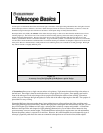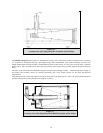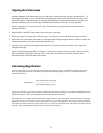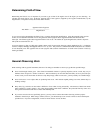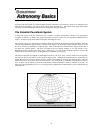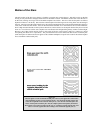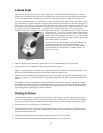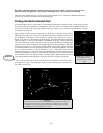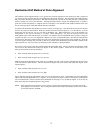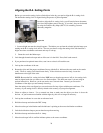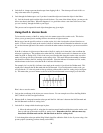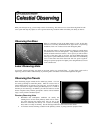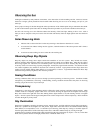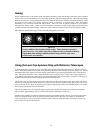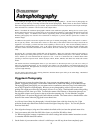
26
igning, do NOT move the telescope in R.A. or DEC. You do not want to move the
ar axis. The telescope is used simply to see where the polar axis is pointing.
Remember, while Polar al
elescope itself, but the pol
t
Like the previous method, this gets you close to the pole but not directly on it. The following methods help improve
your accuracy for more serious observations and photography.
F
F
i
i
n
n
d
d
i
i
n
n
g
g
t
t
h
h
e
e
N
N
o
o
r
r
t
t
h
h
C
C
e
e
l
l
e
e
s
s
t
t
i
i
a
a
l
l
P
P
o
o
l
l
e
e
rallel
Man y
identifying stars in the area. For those in the nort
not too difficult. Fortunately, we have a naked
Polaris, is the end star in the handle of the Little nically
called Ursa Minor) is not one of the brightest co tellations in the sky, it may be difficult to
locate from urban areas. If this is the case, use th
(the pointer stars). Draw an imaginary line throug
to Polaris (see Figure 4-5). The position of the
year and throughout the course of the night (see Fi
sky (i.e., near the horizon), it may be difficul these times, look for
Cassiopeia (see Figure 4-5). Observers in the sout rn hemisphere are not as fortunate as those
in the northern hemisphere. The stars around the h celestial pole are not nearly as bright as
those around the north. The closest star that is re tively bright is Sigma Octantis. This star is
just within naked eye limit (magnitude 5.5) and l s about 59 arc minutes from the pole.
s the point in the northern hemisphere around which all
In each hemisphere, there is a point in the sky around which all the other stars appear to rotate. These points are called
the celestial poles and are named for the hemisphere in which they reside. For example, in the northern hemisphere all
stars move around the north celestial pole. When the telescope's polar axis is pointed at the celestial pole, it is pa
to the Earth's rotational axis.
ou know how to find the celestial pole by
hern hemisphere, finding the celestial pole is
eye star less than a degree away. This star,
Dipper. Since the Little Dipper (tech
y methods of polar alignment require that
ns
e two end stars in the bowl of the Big Dipper
h them toward the Little Dipper. They point
Big Dipper (Ursa Major) changes during the
gure 4-4). When the Big Dipper is low in the
t to locate. During
he
sout
la
ie
The north celestial pole i
stars appear to rotate. The counterpart in the southern hemisphere is referred to as
the south celestial pole.
Figure 4-4 The position of
the Big Dipper changes
throughout the year and the
night.
Definition
Figure 4-5
The two stars in the front of the bowl of the Big Dipper point to Polaris which is less
than one degree from the true (north) celestial pole.
constellation, is on the opposite side of the pole fr
Cassiopeia, the “W” shaped
om the Big Dipper. The North
Celestial Pole (N.C.P.) is marked by the “+” sign.



